Insular area
An insular area of the United States is a U.S. territory that is not one of the 50 states and is not a Federal district. Article IV, Section 3, Clause 2 of the United States Constitution grants to the United States Congress the responsibility of overseeing these territories.[lower-alpha 1] As of 2020, there are 14 U.S. Territories: 3 in the Caribbean Sea and 11 in the Pacific Ocean.[1] These territories are classified by whether they are incorporated (by Congress extending the full body of the Constitution to the territory as it applies to the several states) and whether they have an organized territorial government established by the U.S. Congress through an organic act.[2] All territories but one are unincorporated, and all but four are considered to be unorganized. Five U.S. territories have a permanent, nonmilitary population. Each of them has a civilian government, a constitution, and enjoys some degree of local political autonomy.
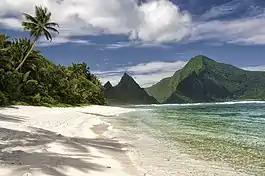

History
The first insular areas that occupied the United States were Baker Island, Howland Island and Navassa Island (1857) then Johnston Atoll and Jarvis Island (both in 1858) would be claimed. After the War between the United States and Spain in 1898, several territories were taken that are still under U.S. sovereignty (Puerto Rico and Guam, both in 1898).[3] Palmyra Atoll was annexed along with the Republic of Hawaii (formerly a Kingdom) that same year. American Samoa was reclaimed the following year (1899). In 1917, at the height of World War I, Denmark sold the Danish Virgin Islands to the United States.[4]
The former British-American condominium of Canton and Enderbury, consisting of the atolls of Canton and Enderbury in the northeast of the Phoenix Islands, became part of this new island state on July 12, 1979, the day of independence from the State of Kiribati.
The U.S. Navy annexed Kingman Reef in 1922. Spain had sold the Northern Mariana Islands to Germany in 1899.[5] The islands passed to Japan, which in turn lost them to the United States in 1945 after the end of World War II. The Guantanamo Bay Naval Base, located on the southern side of Guantanamo Bay and taken from Spain in 1898, is not a U.S. outlying territory but a U.S. military base on formally "leased" land on the island of Cuba.[6]
The Marshall Islands became self-governing in 1979 and fully independent along with the Federated States of Micronesia in 1986. Palau achieved independence in 1994.[7] The three countries maintain sovereignty with free association status with the United States, which provides them with defense assistance and economic resources.
Citizenship
Congress has extended citizenship rights by birth to all inhabited territories except American Samoa, and these citizens may vote and run for office in any U.S. jurisdiction in which they are residents. The people of American Samoa are U.S. nationals by place of birth, or they are U.S. citizens by parentage, or naturalization after residing in a State for three months.[8] Nationals are free to move around and seek employment within the United States without immigration restrictions, but cannot vote or hold office outside American Samoa.[9]
Taxation
Residents of the five major populated insular areas do not pay U.S. federal income taxes but are required to pay other U.S. federal taxes such as import and export taxes,[10][11] federal commodity taxes,[12] social security taxes, etc. Individuals working for the federal government pay federal income taxes while all residents are required to pay federal payroll taxes (Social Security[13] and Medicare). According to IRS Publication 570, income from other U.S. Pacific Ocean insular areas (Howland, Baker, Jarvis, Johnston, Midway, Palmyra, and Wake Islands, and Kingman Reef) is fully taxable as income of United States residents.[14]
Associated states
The U.S. State Department also uses the term insular area to refer not only to territories under the sovereignty of the United States, but also those independent nations that have signed a Compact of Free Association with the United States. While these nations participate in many otherwise domestic programs, and full responsibility for their military defense rests with the United States, they are legally distinct from the United States and their inhabitants are neither U.S. citizens nor nationals.[1]
Current U.S. insular areas by status
The following islands, or island groups, are considered insular areas:
_(cropped).jpg.webp)
Organized incorporated territories
None
Unorganized incorporated territories
One (uninhabited)
.svg.png.webp) Palmyra Atoll – U.S. Territory of Palmyra Island (mostly owned by the Federal Government and The Nature Conservancy; administered by the U.S. Fish and Wildlife Service)
Palmyra Atoll – U.S. Territory of Palmyra Island (mostly owned by the Federal Government and The Nature Conservancy; administered by the U.S. Fish and Wildlife Service)
Organized unincorporated territories
Four (inhabited)
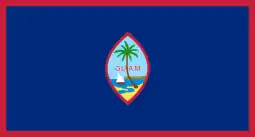 Guam (organized under the Guam Organic Act of 1950)
Guam (organized under the Guam Organic Act of 1950) Northern Mariana Islands (Commonwealth, organized under 1975 covenant)
Northern Mariana Islands (Commonwealth, organized under 1975 covenant)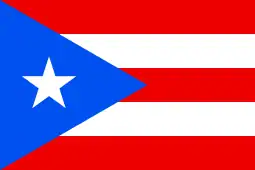 Puerto Rico (Commonwealth, organized under the Puerto Rico Federal Relations Act of 1950)
Puerto Rico (Commonwealth, organized under the Puerto Rico Federal Relations Act of 1950)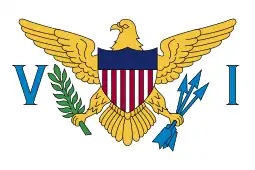 United States Virgin Islands (organized under the 1954 Revised Organic Act of the Virgin Islands)
United States Virgin Islands (organized under the 1954 Revised Organic Act of the Virgin Islands)
Unorganized unincorporated territories
One (inhabited)
 American Samoa (self-governing even though officially unorganized and under the authority of U.S. Department of the Interior)
American Samoa (self-governing even though officially unorganized and under the authority of U.S. Department of the Interior)
Ten (uninhabited)
- Bajo Nuevo Bank (disputed with Colombia and Jamaica; administered by Colombia)
 Howland and Baker Islands
Howland and Baker Islands
 Baker Island (administered as a National Wildlife Refuge)
Baker Island (administered as a National Wildlife Refuge) Howland Island (administered as a National Wildlife Refuge)
Howland Island (administered as a National Wildlife Refuge)
 Jarvis Island (administered as a National Wildlife Refuge)
Jarvis Island (administered as a National Wildlife Refuge).svg.png.webp) Johnston Atoll (administered as a National Wildlife Refuge)
Johnston Atoll (administered as a National Wildlife Refuge) Kingman Reef (administered as a National Wildlife Refuge)
Kingman Reef (administered as a National Wildlife Refuge).svg.png.webp) Midway Atoll (administered as a National Wildlife Refuge)
Midway Atoll (administered as a National Wildlife Refuge).svg.png.webp) Navassa Island (disputed with Haiti)
Navassa Island (disputed with Haiti)- Serranilla Bank (disputed with Colombia, Honduras and Jamaica; administered by Colombia)
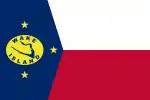 Wake Island (disputed with the Marshall Islands)
Wake Island (disputed with the Marshall Islands)
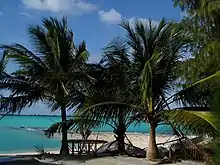
Freely associated states
Three sovereign UN member states which were all formerly in the U.S. administered United Nations Trust Territory and are currently in free association with the U.S. The U.S. provides national defense, funding, and access to social services.
Former territories
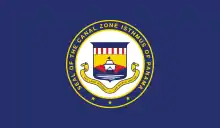 Panama Canal Zone (acquired through 1903 Hay–Bunau-Varilla Treaty; abolished October 1, 1979, by 1977 Torrijos–Carter Treaties[lower-alpha 2])
Panama Canal Zone (acquired through 1903 Hay–Bunau-Varilla Treaty; abolished October 1, 1979, by 1977 Torrijos–Carter Treaties[lower-alpha 2]) Philippines (acquired through 1898 Treaty of Paris; U.S. sovereignty relinquished and the Republic of the Philippines independence recognized July 4, 1946, by the Treaty of Manila)
Philippines (acquired through 1898 Treaty of Paris; U.S. sovereignty relinquished and the Republic of the Philippines independence recognized July 4, 1946, by the Treaty of Manila)
See also
Notes
- Although an archaism, some older federal statutes and regulations still in force refer to insular areas as possessions.
- The Panama Canal itself was under joint U.S.–Panamanian control from 1979 until it was fully turned over to Panama on December 31, 1999.
References
- "Definitions of Insular Area Political Organizations". Washington, D.C.: U.S. Department of the Interior. Retrieved March 3, 2018.
- "Definitions of Insular Area Political Organizations". Washington, D.C.: U.S. Department of the Interior. Retrieved March 11, 2018.
- Tagliaferro, Linda (2004-01-01). Puerto Rico in Pictures. Twenty-First Century Books. ISBN 978-0-8225-0936-3.
- Statistical Abstract of the United States 2001: The National Data Book. U.S. Department of Commerce, Economics and Statistical Administration, Bureau of the Census. 2001. ISBN 978-0-934213-84-4.
- Goldberg, Walter M. (2017-12-08). The Geography, Nature and History of the Tropical Pacific and its Islands. Springer. ISBN 978-3-319-69532-7.
- Hansen, Jonathan M. (2011-10-11). Guantánamo: An American History. Farrar, Straus and Giroux. ISBN 978-0-8090-4897-7.
- J, Clinton, William (1994-01-01). Public Papers of the Presidents of the United States: William J. Clinton, 1994. Best Books on. ISBN 978-1-62376-794-5.
- PBS Newshour, "American Samoans don't have right to U.S. citizenship", Associated Press, June 5, 2015, viewed August 13, 2015.
- US Department of Interior. "Insular Area Summary for American Samoa" Archived 2015-08-20 at the Wayback Machine. viewed August 13, 2015.
- "Puerto Ricans pay import/export taxes". Stanford.wellsphere.com. Archived from the original on April 1, 2010. Retrieved August 14, 2010.
- U.S. State Dept. "Foreign Relations of the United States". Retrieved May 18, 2016.
The people of Puerto Rico will continue to be exempt from Federal income taxes on the income they derive from sources within Puerto Rico, and into their treasury, for appropriation and expenditure as their legislature may decide, will be deposited the proceeds of United States internal revenue taxes collected on articles produced in Puerto Rico and the proceeds of United States tariffs and customs collected on foreign merchandise entering Puerto Rico.
- "Puerto Ricans pay federal commodity taxes". Stanford.wellsphere.com. Archived from the original on 2010-04-01. Retrieved 2011-10-30.
- "Topic Number 903 - U.S. Employment Tax in Puerto Rico". Irs.gov. December 18, 2009. Retrieved January 11, 2019.
- Publication 570 (PDF). Washington, D.C.: U.S. Internal Revenue Service. 2017. Retrieved April 12, 2018.
External links
| Wikimedia Commons has media related to Insular areas of the United States. |
- Department of Interior Office of Insular Affairs
- Department of the Interior Definitions of Insular Area Political Organizations
- Rubin, Richard, "The Lost Islands", The Atlantic Monthly, February 2001
- Chapter 7: Puerto Rico and the Outlying Areas, U.S. Census Bureau, Geographic Areas Reference Manual